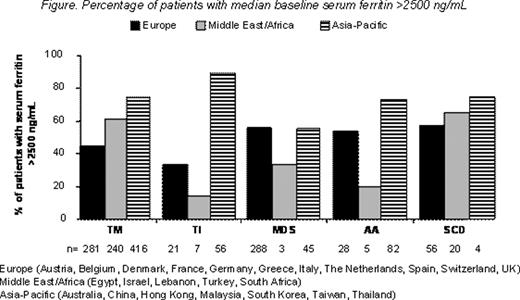Abstract
Abstract 4272
Globally, a number of management guidelines provide recommendations for transfusion and iron chelation therapy across various transfusion-dependent anemias. Most treatment guidelines aim to control body iron burden by maintaining serum ferritin <2500 ng/mL; however, ‘real-world’ practices may not reflect these guidelines and direct comparison of treatment practices between geographical regions are limited. Transfusion history and iron chelation practices prior to study enrolment in the EPIC study (Cappellini MD et al. Haematologica 2010;95:557–66) were evaluated to explore differences across geographical regions.
Patients aged ≥2 years with serum ferritin levels ≥1000 ng/mL, or <1000 ng/mL but with a history of multiple transfusions (>20 transfusions or 100 mL/kg of red blood cells), and liver iron concentration ≥2 mg Fe/g dry weight were enrolled in the study. Baseline data were reported according to underlying anemias: thalassemia major (TM), thalassemia intermedia (TI), myelodysplastic syndromes (MDS), sickle cell disease (SCD) and aplastic anemia (AA), and by geographical regions: Europe, Middle East/Africa and Asia-Pacific.
Of 1744 patients enrolled in the EPIC study, 1558 are included in this analysis (680 from Europe; 275 from Middle East/Africa; 603 from Asia-Pacific; 937 TM, 84 TI, 341 MDS, 116 AA and 80 SCD). Across all regions, patients with TM spent a larger proportion of their lifetime (88–92%) on transfusion therapy compared with other anemias; this was consistent across geographical regions. For patients with TM, mean number of transfusion episodes in the year prior to study entry was lower in the Asia-Pacific region (14.9; n=416; mean patient age 16.2 years) than in Europe (22.7; n=279; mean patient age 24.9 years). In patients with AA, their proportion of lifetime receiving transfusions was also lower in the Asia-Pacific region (20.3%; n=82; mean patient age 33.2 years) than in Europe (42.7%; n=29; mean patient age 36.1 years). The proportion of patients receiving previous iron chelation therapy (deferiprone and/or deferoxamine [DFO]) varied considerably across geographical regions. In all patients, 22% were chelation-naïve; the highest proportion of chelation-naïve patients was in the Asia-Pacific region. In TM patients, the percentage of chelation-naïve patients varied considerably across regions being only 0.4% of patients in Europe compared with 5.4% in the Middle East/Africa and 12.5% in the Asia-Pacific region. For AA patients, 48.3% were chelation-naïve in Europe compared with 76.8% in the Asia-Pacific region. In TM patients, the proportion of their lifetime receiving chelation therapy was lower (48.9%) in the Asia-Pacific region than in Europe (63.6%). In patients with AA, the proportion of lifetime receiving chelation therapy was also lower in the Asia-Pacific region (6.3%; n=19) compared with Europe (26.3%; n=15). Median baseline serum ferritin level was >2500 ng/mL across all anemias. Serum ferritin levels were ≥2500 ng/mL in 61.3% of patients across regions (50.6% [Europe], 59.3% [Middle East/Africa] and 74.3% [Asia-Pacific]). For patients with TM, TI, AA and SCD, serum ferritin levels were substantially higher in the Asia-Pacific region compared with other regions (Figure). In the Asia-Pacific region, the proportion of patients with serum ferritin levels ≥4000 ng/mL varied between 31.1% and 53.6% across anemias, compared with 14.3–37.5% in Europe.
There are many differences in transfusion and iron chelation practices across regions, with most prominent differences in the Asia-Pacific region. Factors contributing to these differences might include regional variations in specific disease characteristics (severity, transfusion requirement), treatment practices (eg, hemoglobin level at which transfusion is initiated), the availability and accessibility of transfusion and iron chelation therapy including patients' compliance and physician attitude and adherence to treatment guidelines. The high proportion of patients with baseline serum ferritin >2500 ng/mL suggests that previous iron chelation regimens with DFO and/or deferiprone prior to the EPIC study were suboptimal with limitations for adequate control of iron burden across geographical regions. A greater improvement in iron chelation practices is warranted across the globe with an immediate focus on the Asia-Pacific region.
Viprakasit:Novartis: Honoraria, Membership on an entity's Board of Directors or advisory committees, Speakers Bureau. Gattermann:Novartis: Honoraria, Research Funding. Porter:Novartis: Membership on an entity's Board of Directors or advisory committees, Research Funding, Speakers Bureau. Taher:Novartis: Honoraria, Research Funding. Habr:Novartis: Employment. Roubert:Novartis: Employment. Domokos:Novartis: Employment. Cappellini:Novartis: Speakers Bureau.
Author notes
Asterisk with author names denotes non-ASH members.


This feature is available to Subscribers Only
Sign In or Create an Account Close Modal